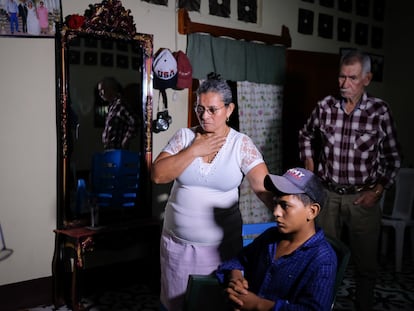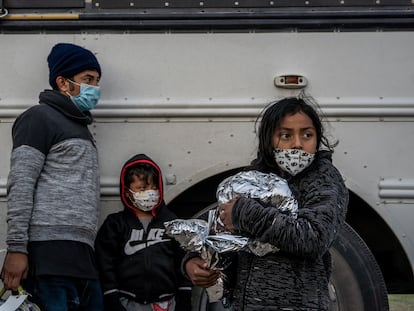The Mexican child soldiers demanding action against drug traffickers
In the indigenous community of José Joaquín de Herrera, youngsters shoot guns in the air in an effort to push the government into action and show their force against criminal groups

Under a burning sun, children armed with guns march in a row in Ayahualtempa, an indigenous village in José Joaquín de Herrera in the Mexican state of Guerrero. As they march, they cry out in support of orphans, widows, indigenous people and General Emiliano Zapata, a leading figure in the Mexican Revolution: “¡Viva! ¡Viva! ¡Viva!” This is the third year in a row that children in the village have joined the adults in a kind of military parade organized by the community police force.
The act is both a call for help and a show of force against the organized crime groups that operate in La Montaña region of Guerrero. These groups are using force to gain ground in the area and take over land to grow poppies. As well as land, the criminal gang Los Ardillos is also after people to work in slave-like conditions to extract opium gum. Those who resist pay a very high price. But José Joaquín de Herrera, a remote village of 600 inhabitants, does not want to give in.
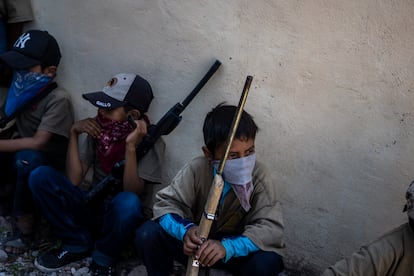
Last year, the strategy to arm children – albeit with toy guns for those aged between seven and 12 – proved successful. The images of the child soldiers sparked international alarm and the Mexican government of Andrés Manuel López Obrador was forced to respond. This year, the self-defense force sought to raise the stakes: not only did the children march with weapons, they also fired them into the air. This happened after they called on the government “to support widows, orphans and the displaced.” “Enough already of crime and discrimination against the indigenous people of Mexico,” they cried. The shots also seemed fake, but they were not.
So-called self-defense groups have a long history in Guerrero and are now present across half the country. These groups are made up of locals who decide to take up arms to defend themselves against potential threats. In the case of autonomous indigenous communities, such as Ayahualtempa, the Mexican Constitution protects their right to decide matters concerning justice and policing. It is a right they exercise, but not always with tact. The rise of organized crime has put these local police officers on the frontline of narco violence, with many losing their lives in shootouts with drug traffickers. People on both sides are killed in these clashes. In 2020, there were six attacks in José Joaquín de Herrera, according to Bernardino Sánchez Luna, a veteran guerrilla who organizes the vigilante groups in the area.
The self-defense force of José Joaquín de Herrera was formed to protect the community but over the years has become a near-military outfit, which is now training children. But why have children become involved in the fight? Why are they being raised with a gun in their hands?
“The government hasn’t fulfilled its promises to us,” responds Sánchez Luna. “We asked for help against the [criminal] groups and they have not provided it. We asked for secondary high school students, because we can’t leave the village, and they have not come. Our job is to work the land, if they don’t want us to arm ourselves, they should give us security.” When asked again about why children need to be involved, the 48-year-old repeats: “The government hasn’t fulfilled its promises to us.”
During the parade in José Joaquín de Herrera, the children wear a cap, leather sandals and a bandana over their mouth and nose, as though they were miniature guerrillas. But they are not toy soldiers but rather children who flash big toothy grins when given a packet of cookies. Dust from the dirt street covers everything and the sun is punishing. The children carry wood guns, while the smallest hold clubs. They rush to line up behind the car with the megaphone. It could almost be a local fiesta. Women, who have little voice in the village, lead the march, followed by the children, then the adults. The adults carry guns that bear the marks of years of struggle: worn-out handles, barrels that have lost their shine and homemade gun slings. More than a show of force, they look like an army that is returning home after years of battle. Defeated.
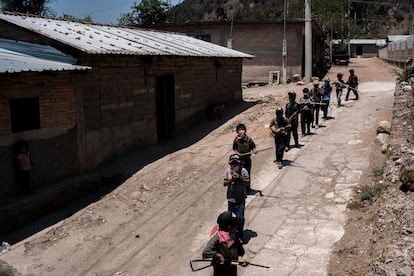
Journalists arrive en masse to report on the parade. The dangerous roads are protected by roadblocks of uniformed soldiers. The reporters are welcome in José Joaquín de Herrera, where no one usually enters, because the village wants to send a message “to the world.” “We are not criminals,” the children say into a microphone in a sports facility with basketball courts. But the simplistic message that blames narcos for all deaths in Mexico hides a more complex reality. In many parts of the country, residents are joining self-defense forces without knowing everything about the group nor who exactly they are defending. In José Joaquín de Herrera, there is only one certainty: they are poor and they don’t want violence, yet generation after generation they continue to take up arms.
Seated at the side of one basketball court are three women who seem removed from the parade. The eldest speaks Náhuatl, as do the other two, but pretends she doesn’t understand Spanish. The youngest, Claudio Bolaños, says she doesn’t want her children to carry a weapon. “It’s up to God. I wouldn’t like my children… but if the village decided it, oh well, I guess,” she says, while nursing her baby in her arms. The 27-year-old also has a five-year-old child.
After the parade, it is time to decide who to vote for on June 6, when Mexico will elect 20,000 public officials and 15 governors, including the governor of Guerrero. The candidate who was nominated by the governing National Regeneration Movement (Morena) party is Félix Salgado Macedonio, who has been accused of two counts of rape and several of sexual assault. His candidacy was annulled by Mexico’s National Electoral Institute (INE) over fiscal irregularities and it is up to the Federal Electoral Tribunal (TEPJF) to decide whether he can still stand for election. But how much of this is known in the mountainous community of José Joaquín de Herrera where there is no television? Sánchez Luna says little or nothing about the subject. No candidate, according to the guerilla, has come to the village.
The state is notably absent in the indigenous community. Have they been abandoned? “You could say so,” says Romain Le Cour, a French-Argentine sociologist. “In the face of the simplistic discourse that the drug trade is to blame for everything, authorities end up looking the other way – nothing can be done, they seem to say.” Le Cour has been living in Mexico for 12 years and works for the international NGO Noria, which specializes in violence. “What is happening here [in José Joaquín de Herrera] is much more complex,” he explains. “It is about a social problem, a problem of poverty and neglect. It is not enough to blame narco-violence and leave indigenous communities to govern themselves without support.” Simplistic messages lead to simplistic solutions, he says, and José Joaquín de Herrera needs more if it is to regain peace.
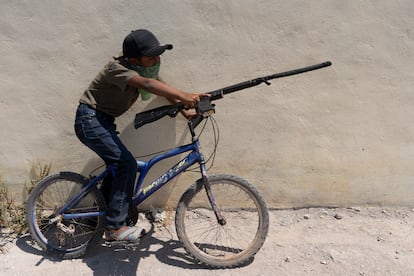
In the village, there are nine widows, 14 orphans and 34 people who have been displaced from nearby communities. And they are isolated. A doctor only comes when there is an emergency and they are also responsible for taking care of the sick in other communities. Traders come to sell basic goods, on the condition that they are paid for in advance. And there is of course the truck that delivers Coca-Cola. “And the Pepsi truck,” laughs Sánchez Luna. But little more than that. When children finish primary school, they stop studying because going to high school would mean traveling kilometers away, where they risk being shot or kidnapped. Nor do family members visit the village. When people point to the mountains in this area, they don’t think of farms growing corn, beans and pumpkins, but rather shotguns.
Next to some grazing goats, black and white pigs are tied to a rope and a donkey brays in the distance. The cries of the parade can be heard across the field: “Strong children, now! Take up arms, now! If there is no one to defend us, we are going to respond with force to the hitmen, the sons of bitches!” A round of fire leaves small puffs of smoke in the air. The sound of the shots echoes in the mountains.
English version by Melissa Kitson.
Tu suscripción se está usando en otro dispositivo
¿Quieres añadir otro usuario a tu suscripción?
Si continúas leyendo en este dispositivo, no se podrá leer en el otro.
FlechaTu suscripción se está usando en otro dispositivo y solo puedes acceder a EL PAÍS desde un dispositivo a la vez.
Si quieres compartir tu cuenta, cambia tu suscripción a la modalidad Premium, así podrás añadir otro usuario. Cada uno accederá con su propia cuenta de email, lo que os permitirá personalizar vuestra experiencia en EL PAÍS.
¿Tienes una suscripción de empresa? Accede aquí para contratar más cuentas.
En el caso de no saber quién está usando tu cuenta, te recomendamos cambiar tu contraseña aquí.
Si decides continuar compartiendo tu cuenta, este mensaje se mostrará en tu dispositivo y en el de la otra persona que está usando tu cuenta de forma indefinida, afectando a tu experiencia de lectura. Puedes consultar aquí los términos y condiciones de la suscripción digital.
More information
Archived In
Últimas noticias
Maduro pleads not guilty before the federal court in New York: ‘I am still the president of Venezuela’
A new test can detect Alzheimer’s from a finger prick
UN team enters Sudanese city of El Fasher after paramilitary massacre: ‘It’s like a ghost town’
A recipe for resistance: Indigenous peoples politicize their struggles from the kitchen
Most viewed
- Gilles Lipovetsky: ‘If you want to live better and fall in love, take Prozac, don’t look to philosophy’
- Alain Aspect, Nobel laureate in physics: ‘Einstein was so smart that he would have had to recognize quantum entanglement’
- Alvin Hellerstein, a 92-year-old judge appointed by Bill Clinton, to preside over Maduro’s trial in New York
- Why oil has been at the center of Venezuela-US conflicts for decades
- Cuba confirms death of 32 of its citizens in the US attack against Venezuela

